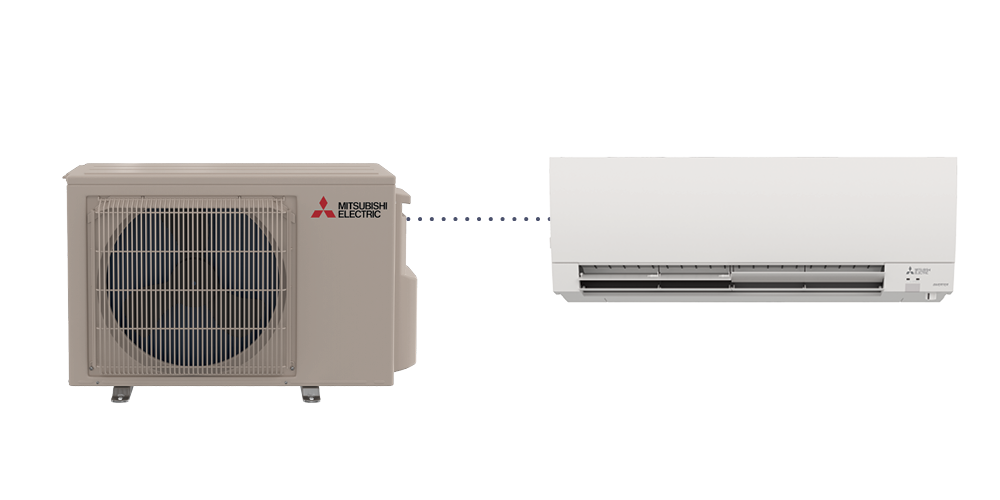When it comes to cooling your home, choosing between a Mini Split vs Central Air Conditioner can have a big impact on your comfort, energy usage, and budget. This article explores the Ultimate Showdown between these two popular systems, breaking down their details to help homeowners find the best option for their home.
Picking the right cooling system isn’t just about dealing with hot weather; it’s about being efficient, cost-effective, and fitting the specific needs of your living space. With factors like installation difficulty and energy efficiency being important in this decision-making process, it’s crucial to understand the differences between mini-split and central air conditioners.
For those interested in multi-split air conditioners and how they can customize temperature control in different areas of your home, you can learn more at Always On HVAC.
If you’re thinking about replacing an old boiler system with a more efficient option, consider why a mini-split might be a good choice by checking out Always On HVAC’s guide on replacing old boiler systems.
And if you want to know more about the benefits of ductless options and efficient cooling methods, take a look at Always On HVAC’s article on the benefits of a ductless mini-split AC, which explores how these systems can provide efficient cooling while also being cost-effective.
As we explore the advantages and disadvantages of each system, remember that your home is where this showdown takes place. The right choice combines what you like with what makes sense to ensure you’re comfortable at home.
Understanding Mini Split Systems
Mini Split Systems have revolutionized the way we cool our living spaces. Unlike traditional air conditioning systems, mini splits work on a straightforward principle: they distribute cooling (and often heating) directly to specific zones within a home or office without the need for extensive ductwork.
How Do Mini Split Systems Work?
The heart of a mini-split system is a partnership between two main components:
- Outdoor Compressor Unit: This unit is installed outside the home and is responsible for expelling heat from the indoor space.
- Indoor Air Handling Units: Typically mounted on walls or ceilings, these units deliver cooled air into their respective zones. Each zone has its own thermostat, allowing for precise temperature control.
When activated, the outdoor unit compresses refrigerant and pumps it to the indoor units where it absorbs interior heat. The refrigerant cycles back outdoors, releases the heat, and returns inside to repeat the process.
Benefits of Mini-Split Systems
Mini-split systems boast several advantages that make them an attractive option for homeowners:
- Individual Temperature Control: With separate thermostats for each zone, occupants can customize temperatures to their comfort levels.
- Energy Efficiency: By avoiding the energy losses associated with ductwork and enabling targeted cooling, mini-splits are typically more efficient than traditional systems. For those interested in maximizing their system’s efficiency, consider implementing smart energy savings strategies specifically designed for mini-splits.
Drawbacks of Mini-Split Systems
Central air conditioning systems have become a common feature in many homes, providing a reliable and effective solution for staying cool. These systems work on the principle of centralized cooling, which ensures consistent temperature control throughout the entire building or house.
Understanding Central Air Conditioning Systems
PTAC units, or Packaged Terminal Air Conditioners, are robust systems commonly found in commercial settings, such as hotels, but are also well-suited for residential use. These self-contained units are capable of providing both heating and cooling, making them a versatile option for year-round climate control.
How Do Central Air Conditioning Systems Work?
- Outdoor Compressor Unit: This component pressurizes the refrigerant and removes heat from the home.
- Indoor Air Handler: Usually located in a basement or utility area, this houses the evaporator coil and blower fan.
Requirement of Ductwork for Central Air Conditioning Systems
- Lower Installation Costs: When there are existing ducts in place, installing central air can be cheaper than setting up multiple mini-split units.
- Heating Capability: Many central units also function as heating systems, providing a complete climate control solution.
- Hidden Appearance: Unlike mini-splits that have visible indoor units, central air components are usually concealed from sight, preserving the aesthetics of your interior.
Drawbacks of Central Air Conditioning Systems
- Lower Energy Efficiency: These systems may use more energy due to potential heat loss in ductwork and less precise temperature regulation.
- Less Accurate Heating and Cooling: Unlike mini-splits that can individually target rooms, central air offers one thermostat setting for an entire area.
- Possible Additional Costs for Ductwork Installation: Homes without existing ducts will face significant extra expenses for installation.
By understanding how mini-split systems and central air conditioning systems work, homeowners can make informed choices about their cooling requirements based on a thorough understanding of each system’s details.
If you’re interested in exploring alternatives to central air conditioning, you may want to consider the benefits of mini-split systems. These systems offer energy efficiency and individual room temperature control, making them a top choice for many homeowners.
Key Factors to Consider When Choosing Between Mini Split and Central Air Conditioning Systems
Selecting the right air conditioning system is crucial for both comfort and energy efficiency in your home. There are several key factors to consider when deciding between a mini split or central air conditioning system:
1. Home Size and Layout Considerations
- Mini Split Systems: These are ideal for smaller homes or spaces where you want individual control over each room’s temperature. The ability to set different temperatures in different areas (zoning capability) is a major advantage of mini splits.
- Central Air Conditioning: This type of system is typically more suitable for larger homes with multiple rooms. If your main priority is maintaining a consistent temperature throughout the entire house, then a central air conditioning system might be the better choice.
2. Availability of Existing Ductwork
- If your home already has ductwork in place from a previous heating or cooling system, it may be more cost-effective and convenient to opt for a central air system that can utilize this existing network to distribute conditioned air.
- On the other hand, if you don’t have ducts or prefer not to install them, mini splits offer a ductless alternative that can be easier to retrofit into older homes or spaces without major renovations.
3. Energy Efficiency Comparison
- Mini split systems generally have an edge when it comes to energy efficiency due to their ductless design, which helps minimize energy loss.
- Central air conditioning systems, on the other hand, can experience some energy loss through the ductwork if it’s not properly sealed and insulated.
4. Aesthetic Appeal and Visibility Preferences
- It’s important to consider how the different types of air conditioning systems will look in your home and whether they align with your aesthetic preferences.
- Mini splits are visible within the living space as they require wall-mounted indoor units in each room. While they can be sleek and modern in design, they may not blend seamlessly with all decor styles.
- Central air systems, on the other hand, are hidden from view as they use ductwork to deliver conditioned air throughout the house. The only visible elements are the vents or registers in each room.
In cases where aesthetics are paramount, homeowners might lean towards central systems for their inconspicuous nature. However, those prioritizing efficiency might find the visibility of mini splits to be a worthwhile trade-off for lower operating costs.
By carefully considering these factors, you’ll be able to make an informed choice that takes into account your home’s specific needs, your personal preferences, and your goals for energy efficiency.
Making the Right Choice: Mini Split vs Central Air Conditioner
When it comes to cooling your home, the decision between mini-split and central air conditioning systems hinges on a variety of factors tailored to your specific circumstances. Here’s a distilled comparison to guide you:
Mini Split Systems
- Individual Temperature Control: Each room or zone has its own thermostat.
Energy Efficiency: Generally more efficient due to no ductwork losses. - Installation Flexibility: Ideal for homes without existing ductwork.
Visibility: Components are visible inside the home.
Central Air Conditioning Systems
- Cost-Effective Installation: Often less expensive if ductwork is present.
- Heating Capability: Can easily integrate with heating systems for year-round comfort.
- Inconspicuous: Equipment is mostly out of sight.
- Whole-Home Comfort: A single thermostat controls the temperature throughout the home.
As you weigh these points, remember that choosing a system that aligns with your priorities is crucial. Whether it’s the efficiency and individualized control of a mini-split or the seamless integration and whole-home comfort of central air, your decision should reflect your unique needs.
For more insights into split system HVAC technology, you can explore A Comprehensive Overview Of Split System HVAC – Part II. If energy savings and comfort are your focus, consider reading about the benefits of Installing a Mini Split Unit in Your Home.
By carefully considering each factor—home size and layout, existing infrastructure, efficiency ratings, and aesthetic preferences—you can make an informed decision that ensures comfort and satisfaction for years to come.







Leave A Comment